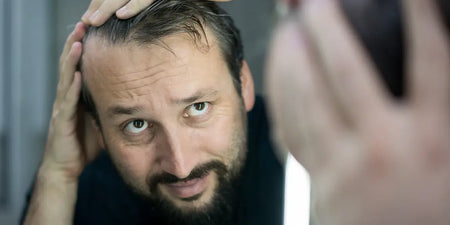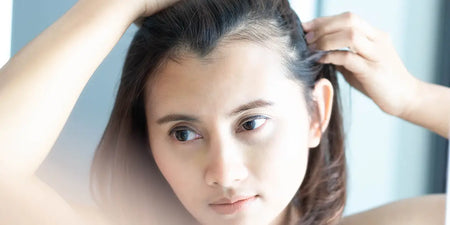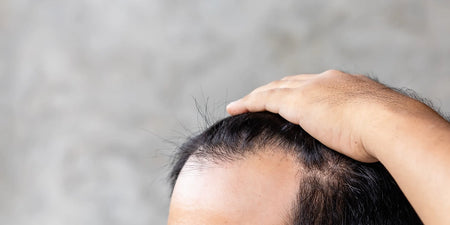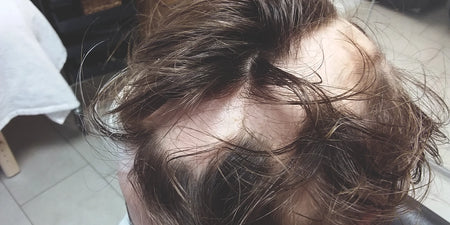Geheimratsecken bei Frauen & Männern: Ursachen, Kaschieren und Behandlung
If more and more hair is falling out at your hairline, you may be suffering from a receding hairline. It affects many men and often occurs between the ages of 20 and 30 - but women can also be affected by receding hairlines. The issue is of concern to many people and is often associated with a great deal of suffering.
In this article, we summarize how receding hairlines develop and the causes of hair loss. We will also show you how to prevent receding hairlines and which hairstyles you can use to skilfully conceal bald patches. We will also explain which treatment methods are available and how YELASAI hair care products can stimulate your natural hair growth.
First signs: How do receding hairlines develop?
The receding hairline often develops gradually and begins with hair loss at the temples.
Learn moreHormonal causes of receding hairlines in women & men:
A receding hairline is often caused by a congenital hypersensitivity to the hormone dihydrotestosterone.
Learn moreAn overview of other reasons for hair loss:
A receding hairline and hair loss can also be caused by the menopause, malnutrition or a skin disease.
Learn moreCan receding hairlines be prevented?
If receding hairlines are caused by a genetic predisposition, they are difficult to prevent.
Learn moreFirst signs: How do receding hairlines develop?
The receding hairline, also known as calvities frontalis, develops gradually. At first, they only fall out slowly at the temples. At first, the hair continues to grow back, but it becomes finer and thinner.
Over time, more and more hair falls out and the hairline gradually moves further back. This often results in a semi bald head. Depending on the type of hair loss, the hair roots eventually die and there is no more hair growth.
A receding hairline can affect both women and men. However, they occur more frequently in men: For some, receding hairlines only develop in old age. At the same time, many young men between the ages of 20 and 30 also suffer from hair loss and receding hairlines. It is therefore not just older men who develop receding hairlines - this form of hair loss affects many people of all ages.
Psychological stress in young men with receding hairlines
A receding hairline is often a major psychological burden for those affected. Men who suffer from hair loss at a young age often have a particularly hard time with it. This can cause mental illnesses such as depression or anxiety. This is because receding hairlines are often the cause of ridicule from peers. They can also lead to disadvantages in the professional world and make it more difficult to find a partner. The psychological strain can be enormous and affect the whole life of those affected. Psychotherapy can help to deal with the situation better.
Hormonal causes of receding hairline in women & men
A receding hairline is often caused by hormonal factors. Strictly speaking, they are a form of hereditary hair loss (androgenetic alopecia). Those affected have a congenital hypersensitivity to the hormone dihydrotestosterone (DHT for short). This is a metabolic product of testosterone. As men produce significantly more testosterone, they are also more often and more severely affected by receding hairlines.
Many people are not sensitive to DHT, but those who suffer from hereditary hair loss are. DHT ensures that the growth phase of the hair is shortened and the hair follicles die off over time.
It is not uncommon for grandfathers, fathers and grandchildren to all suffer from receding hairlines. Research now assumes that a large number of genes can influence hair growth. This means that hereditary hair loss can be passed on not only through the father's genes, but also through the mother's. If many people in your family have receding hairlines, this may be genetic hair loss that is passed on from generation to generation.
In fact, around 40 percent of all men suffer from hair loss in the course of their lives. For women, the figure is around 20 to 30 percent.
Other reasons for hair loss at a glance
The development of receding hairlines does not necessarily have to be caused by hereditary factors. There are other diseases and situations that can promote hair loss and receding hairlines. We summarize these for you:
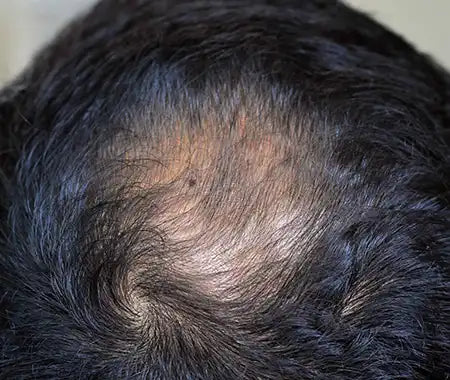
Circular hair loss:
A receding hairline can also be caused by circular hair loss(alopecia areata). This is often accompanied by massive hair loss, in which round bald patches form on the head within a short period of time. It can be caused by severe stress, an autoimmune disease or genetic predisposition.
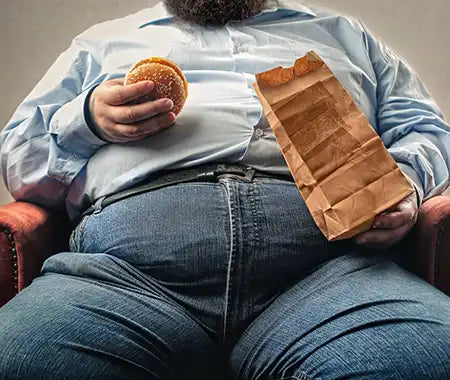
Unhealthy lifestyle & nutrient deficiency:
An unhealthy lifestyle associated with obesity and little exercise can also lead to receding hairlines and hair loss. This also applies to a lack of important nutrients. Hair loss can also be triggered by bulimia or anorexia.
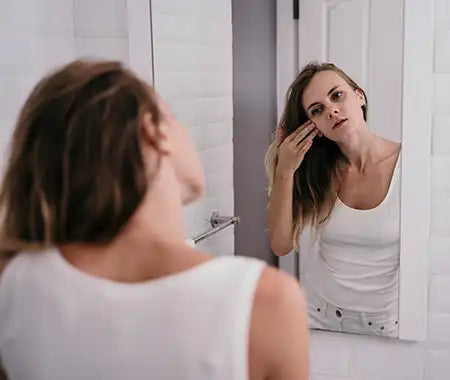
Hormonal fluctuations:
In women in particular, receding hairlines can be caused by hormonal changes. Hormones fluctuate greatly during pregnancy, which can promote hair loss. Hair loss during the menopause is also very common, as oestrogen levels fall and there is more testosterone in the blood.
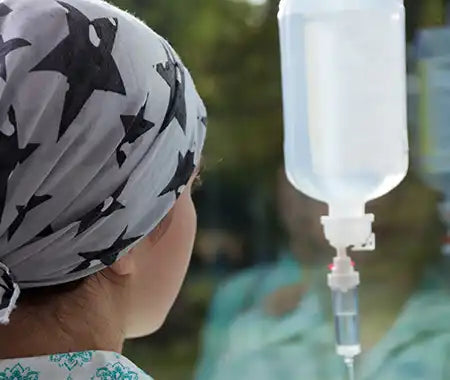
Chemotherapy:
Cancer treatment with chemotherapy is also associated with hair loss. The therapy damages your cells - including the hair root cells, which are attacked by the aggressive treatment. However, hair often grows back after the therapy has been successfully completed.
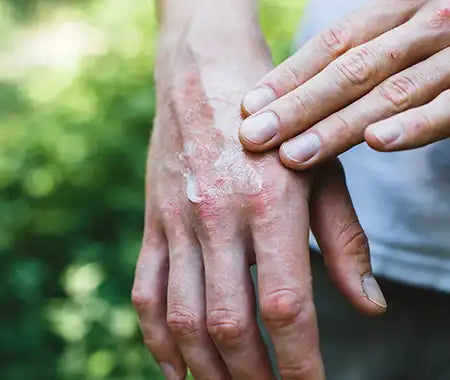
Skin diseases:
Another cause of receding hairline can be skin diseases. If you suffer from a fungal infection, psoriasis or inflamed areas on the scalp, these can also be responsible for hair loss.
As you can see, in addition to androgenetic alopecia, i.e. hereditary hair loss, there are many other causes of receding hairlines. As a rule, it is relatively easy to recognize why receding hairlines develop. If you would like to find out more about this topic, you can find further helpful articles on our hair loss blog.
Can receding hairlines be prevented?
It is not always possible to prevent receding hairlines. It depends on the particular trigger. If your father and grandfather have receding hairlines or a bald head, then this is probably due to hereditary hair loss. This is caused by a hypersensitivity to the hormone dihydrotestosterone. This hypersensitivity is difficult to treat - prevention is therefore virtually impossible.
What can help, however, is to put as little stress on the hair as possible. Eat a healthy and balanced diet. This will provide your body with all the nutrients it needs. A healthy lifestyle with little alcohol is also recommended. Exercise regularly and keep an eye on your weight.
Hair loss in men and women can be promoted by severe stress. Therefore, try to relax and plan enough time for yourself and your well-being. You can counteract stressful phases by exercising after work or pursuing your hobbies.
Another important point is the hairstyle you wear. Tight hairstyles damage the hair roots and hair follicles in the long term. Therefore, try to vary your hairstyles as often as possible.
Conceal receding hairline: These hairstyles are particularly helpful
If you suffer from a receding hairline or hair loss, you will want to conceal the bald patches. There are a number of suitable hairstyles for men and women.
Men with a full head of hair should let it grow as long as possible. The sides should then be cut very short to conceal the bald patches.
At the same time, many men try to distract from the loss of hair with a full beard. The facial hair directs the focus to the lower part of the face and thus skillfully distracts from the receding hairline. In this case, make sure you take care of your beard.
It is also advisable for women to cut their hair shorter. This is because short hairstyles can often hide thinning areas better than long hair. It's best to opt for a middle parting, as a side parting emphasizes the receding hairline. You could also opt for bangs that skilfully cover the bald patches.
Men and women also benefit from coloring their hair. Grey hair looks thinner because the color is missing. With a fresh tint, hair can look much fuller straight away. Caps and hats can also conceal receding hairlines and thinning areas.
Hair transplantation for receding hairline?
For many of those affected, receding hairlines are associated with a great deal of psychological stress. This is why young people in particular opt for a drastic step: a hair transplant.
This involves transplanting healthy hair roots from the back of the head to the bald patches. These grow back there and the receding hairline disappears after a few months.
However, there are various prerequisites as to whether a hair transplant is possible. First, the cause must be identified. If the hair loss is caused by an illness or a deficiency, these triggers must be eliminated.
Furthermore, a hair transplant cannot take place while the hair is still falling out. This is because the newly transplanted hair would then also fall out. If the hair loss has reached its natural end, you can talk to a doctor about a possible hair transplant.
Risks of a hair transplant
A hair transplant is an operation that is associated with numerous risks and side effects. The scalp can become inflamed as a result of the procedure and scarring is also possible. This can be associated with severe pain and swelling. At the same time, the transplanted hair roots may not grow and the procedure may not have the desired effect.
Can receding hairlines be treated with medication?
In many cases, people who suffer from receding hairlines wish they could solve or treat the problem. In fact, there are now a variety of methods to combat receding hairlines and support natural hair growth.
The most common method for treating receding hairlines and hair loss is drug therapy. The active ingredient minoxidil can be prescribed. Both men and women can apply the medication as a foam to the scalp. The effectiveness of minoxidil has been clinically proven.
However, there are also some disadvantages to minoxidil. The drug does not work for everyone. It also has side effects and can cause irritation and inflammation. Another problem is that hair loss continues after the drug is discontinued.
Male receding hairlines can also be treated with finasteride. The active ingredient is taken in tablet form and prevents the body from converting testosterone into dihydrotestosterone. However, this active ingredient is only approved for men.
For both men and women, receding hairlines should be treated as early as possible. The earlier the treatment begins, the better the effect usually is. Those affected should bear in mind that the effect of the treatment usually wears off after the end of therapy and hair loss progresses.
Further treatment options for receding hairlines
In recent years, numerous other procedures have been developed to treat receding hairlines. These include PRP therapy, for example. This involves injecting the patient's own blood into the affected areas of the scalp. This is intended to stimulate hair growth.
Stem cell therapy can also be used to treat receding hairlines. This involves taking cells from the blood that are not hypersensitive to DHT. These are then injected into the scalp. It is also possible to combine these two methods to achieve the greatest possible effect.
There are also many simple everyday tips that you can use to support the growth of your hair. Have your doctor check your blood: Hair loss can be caused by iron deficiency, for example. Try to eat a healthy and balanced diet to provide your body with the best possible nutrition.
You should also use a suitable hair care product. This should be as mild and gentle as possible, as aggressive shampoos and styling products can put additional stress on your scalp.
Support hair growth with natural hair care products from YELASAI
If you have a receding hairline, you should first try to support it with targeted care products. With specific care for your scalp, you can promote your natural growth and rebalance your hair cycle.
YELASAI hair care products contain natural ingredients that are supplemented with natural, fermented herbs. They contain no synthetic substances, hormones, nanoparticles or petroleum products. This makes them particularly gentle on your scalp and cares for it gently instead of irritating or stressing it.
We offer you a carefully compiled hair care set for receding hairlines. This practical set provides you with all the products you need to give your hair the best possible care for receding hairlines. It contains a shampoo, a scrub, a tonic and an oil. All products are specially formulated to support your hair growth.
Our Ayurveda Hair Active Shampoo cleanses your scalp particularly thoroughly but gently. It removes grease, sebum and residue from old shampoos. This immediately makes your hair feel better. To cleanse the scalp even more intensively, we recommend our Ayurveda Skin & Scalp Active Enzyme Peeling. The enzyme peeling ensures a vital scalp: It gently but effectively removes skin flakes. This is particularly beneficial for bald patches or thinning hair.
The enzyme scrub also prepares your skin for the absorption of nourishing nutrients. You should then apply the Ayurveda Hair Active Tonic. The scientifically proven tonic was developed to activate and promote hair growth. It is simply applied to the scalp and gently massaged in.
The hair care set for receding hairlines also contains Ayurveda Hair & Scalp Active Oil. This provides your scalp with nourishing oils. This makes it ideal to use to prepare your scalp for washing. It also helps with dry, itchy and taut scalps.
If you want to take the best possible care of your hair, the natural hair care products from YELASAI are the right choice.
Frequently asked questions about receding hairlines & hair loss in men and women
Yes, receding hairlines can grow back under certain conditions. The trigger for the hair loss is decisive. If this is caused by a nutrient deficiency, stress or an illness, the cause can be remedied and the hair will grow back. However, in the case of hereditary hair loss, the hair will not grow back.
The receding hairline can occur at any age. Men are often affected between the ages of 20 and 30. In women, receding hairlines usually appear from the age of 50. However, there can also be exceptions where men only develop receding hairlines in old age or women are also affected at a younger age.
It usually takes several years for receding hairlines to develop into baldness. Not all people with receding hairlines develop baldness: hair loss has a natural end and does not progress indefinitely in most people. The progression can be very individual.
Yes, receding hairlines can also occur with long hair - many women are affected by hair loss and receding hairlines in the course of their lives. However, depending on the cause of the hair loss, it can also stop again and the hair then grows back.
Our conclusion: Care for your hair & scalp with natural products from YELASAI
A receding hairline is a problem for many people, but before you resort to medication with strong side effects, you should support your hair growth with the right care. At YELASAI, we have developed products that are designed specifically for your situation.
They offer you gentle cleansing and care for your scalp at the same time. Their natural and specially selected ingredients can promote your natural hair growth. They are completely natural, mild and have no side effects.
Take a look at our product range or get advice from one of our local hair growth specialists.
